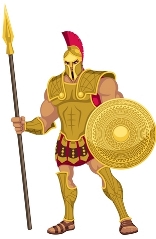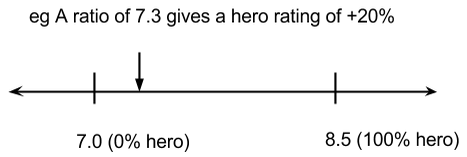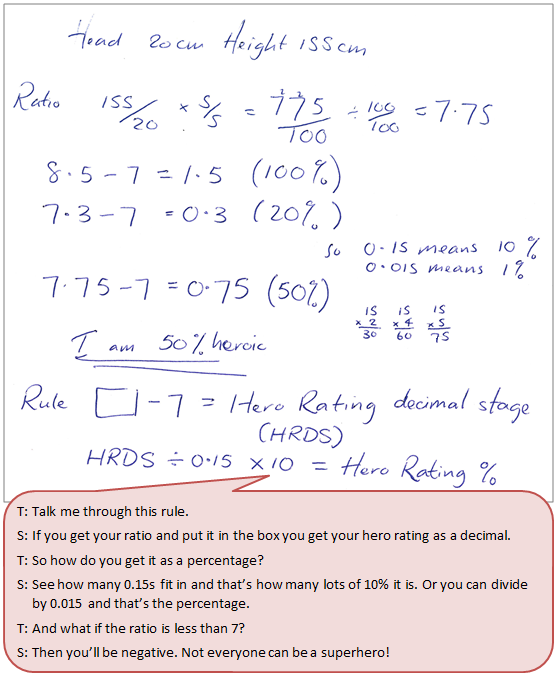The purpose of this activity is to engage students in a practical investigation that leads to comparing fractions and/or decimals quantitatively.
This activity assumes the students have experience in the following areas:
- Measuring lengths in metric units.
- Calculating fractions to represent a proportion.
- Comparing quantities with multiplicative operators, e.g., three times larger.
- Calculating percentages of amounts.
The problem is sufficiently open ended to allow the students freedom of choice in their approach. It may be scaffolded with guidance that leads to a solution, and/or the students might be given the opportunity to solve the problem independently.
The example responses at the end of the resource give an indication of the kind of response to expect from students who approach the problem in particular ways.

In images of Greek gods and heroes, their full height tends to be 8 1/2 lots of their head height.
The average year 7 or 8 student has a height to head height ratio of 7.
Measure your full height and head height (in the same units), to find your height to head height ratio.
Use this ratio, and the example below, to say how much of a hero you are.
The following prompts illustrate how this activity can be structured around the phases of the Mathematics Investigation Cycle.
Make sense
Introduce the problem. Allow students time to read it and discuss in pairs or small groups.
- Do I understand the situation and the words? (Students may need to understand the Greek love of perfect proportion and what ratio is used in this context.)
- What are the important words and symbols? (A ratio is a multiplicative relationship between two measures with the same units. On this case the ratio is between head height and full height.)
- Does this look/sound like a problem I have worked on before? (Students may encounter ratios in other situations such as mixing paint, bicycle gears, and students in a classroom.)
- What will my solution look like? (The solution will be a percentage that compares their ratio to that of a perfect God. It will also include working and justification.)
Plan approach
Discuss ideas about how to solve the problem. Emphasise that, in the planning phase, you want students to say how they would solve the problem, not to actually solve it.
- What are the maths skills I need to work this out? (Finding equal ratios and comparing ratios will be needed.)
- What could the solution be? What is a sensible estimate? (100% is unlikely since humans vary in the ratio of head to full height. However, a range between -90% and + 100% seems reasonable.)
- What else do I need to know to get started?
- How could I show this problem using numbers, pictures, graphs, tables, or materials?
- What strategies can I use to get started? Might I start with some examples where the measurements are easy numbers to work with?
- What tools (digital or physical) could help my investigation? (Students will need rulers or tape measures, and calculators.)
Take action
Allow students time to work through their strategy and find a solution to the problem.
- How am I measuring head and full height? How can I be as accurate as possible?
- Am I showing my workings in a clear, systematic way that is easy for others to understand?
- How can we share the mahi in our group to get the best result?
- How might we share our results to see if our strategy works for many cases?
- Have I recorded my ideas in a way that helps me to see patterns?
- Do we expect there to be a pattern or will there be too much variation?
- Does my solution answer the question? How can I improve my solution?
- Is there another possible answer or way to solve it?
Convince yourself and others
Allow students time to check their answers and then either have them pair share with other groups or ask for volunteers to share their solution with the class.
- What is the solution?
- Is there evidence from other people that the strategy works?
- Am I sure that I considered all the information?
- How would I convince someone else I am correct?
- Could I have solved the problem in a more efficient way?
- Would my answer work in a different situation? (Other body proportions are interesting. Consider using da Vinci’s Vitruvian man.)
- Which ideas or tools worked well in my investigation?
- How did my understanding of ratios and percentages help me?
- What more do I need to learn?
Examples of work
Work Sample 1
The student expresses ratios as fractions and coverts the difference in ratios to a percentage.
Click on the image to enlarge it. Click again to close.
Work Sample 2
The student expresses ratios using fractions, and connects percentages and lengths to express their own hero status.


